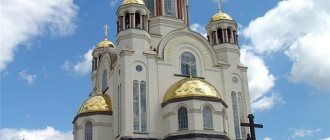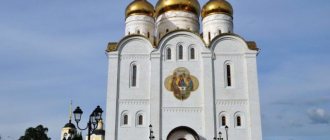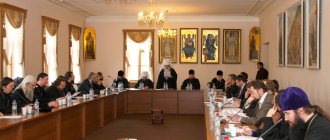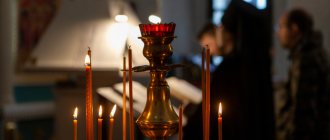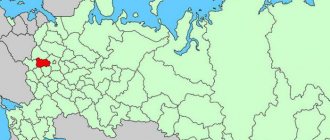| Tula Assumption Cathedral. Photo by Denis Kabanov, 2000s. |
Tula and Ephraim Diocese
of the Tula Metropolis of the Russian Orthodox Church
- Diocesan administration: Russia, 300000, Tula, st. Zhukovsky, 61
- Tel.: (4872) 36-39-95, 31-24-60, 36-15-07
- Official site:
- Canonical territory: Bogoroditsky, Venevsky, Volovsky, Efremovsky, Kimovsky, Kireevsky, Kurkinsky, Leninsky, Uzlovsky districts; Tula, Novomoskovsk, Donskoy GO, Tula region.
- Cathedrals: Assumption (Kremlin) in Tula, All Saints in Tula, Assumption “Black” (former monastery) in Tula, Church of the Icon of the Mother of God “Seeking the Lost” in Efremov
- On the map: Yandex.Map, Google map
Background
In 1261, Metropolitan Kirill III established the Sarai diocese, which, with the weakening of the khan’s power, was transferred by Bishop Vassian around 1460 to Moscow to “Krutitsy,” which was called Krutitskaya.
Since 1350, this diocese has been in charge of the western part of the Tula province with the cities of Novosil, Odoev, Belev and Cherny. Another part of the Tula cities was ruled by the Ryazan bishops for 415 years (from 1207 to 1622). This division of the cities of the Tula region between the Ryazan and Krutitsa dioceses was finally approved by St. Metropolitan Alexy around 1360, giving the Ryazan diocese the lands on the left, and the Krutitsa diocese the lands on the right side of the Don River [1]. Thus, Tula, Venev and other cities, except for Aleksin, which belonged to the Moscow Metropolitanate, and Kashira, which belonged to the Kolomna diocese, became dependent on the Ryazan diocese, which was consistent with the boundaries of civil administration, which then covered almost the entire northeastern part of the Tula province belonged to the Ryazan principality. In 1622, Patriarch Filaret (Romanov) transferred the cities of the future Tula province: Aleksin, Tula, Dedilov, Gremyachev and Epifan to the Kolomna diocese, to which Old Kashira, located on the Moscow side - the left bank of the Oka River, had long belonged, which is why the bishops of Kolomna from the time of its establishment before the abolition of the Kolomna diocese they were called Kolomna and Kashirsk. Kashirsky district, located on the Tula side - the right bank of the Oka River, belonged to the Ryazan department. By the definition of the Moscow Council of 1674, it was given to the Kolomna diocese in 1675, and in return the cities of Gremyachev and Epifan with their counties were returned to the Ryazan department. At the same time, the city of Venev was transferred to the Kolomna diocese from Ryazan, and the city of Bogoroditsk, built in 1622, was transferred to the Ryazan diocese from Kolomensk, about the rights to which there was a dispute in 1675 between the Kolomna and Ryazan dioceses [2].
In 1682, Patriarch Joachim intended, having separated Tula from Kolomna, to establish new episcopal departments in Tula, as well as in Belyov and Kashira, with their subordination to the Moscow patriarchal throne [3], but due to the death of Tsar Feodor Alekseevich and the Streltsy rebellion that happened at the same time The patriarch's assumption could not come true.
The Tula Church, in addition to subordination to the above three dioceses, was partially dependent on other dioceses: the city of Efremov from 1764 to 1767 was expelled from the Kolomna diocese to Voronezh, where it was under the control of St. Tikhon; in 1774, the city was transferred from the Krutitsk diocese to the Voronezh diocese. Novosil.
In 1777, the Tula governorship was opened, which included cities that until that time belonged to different provinces: Tula, Aleksin, Belev, Venev, Odoev, Kashira, Krapivna, Epifan, Chern, Efremov, Novosil, Bogoroditsk and those left without a district - Dedilov and Gremyachev. In 1788, according to the decree of Tsarina Catherine II, given on May 6 to the Holy Synod with the aim of bringing the divisions of the boundaries of the dioceses, if possible, in accordance with the boundaries of the provinces, it was ordered: 1) there should be no Krutitsa diocese, and the Kaluga province should be annexed to the Moscow one; 2) at the end of the war, establish a bishop's house in Tula, and include the Tula viceroyalty in the Kolomenskaya diocese, naming its bishop, the newly installed Afanasy (Ivanov), Kolomensky and Tula.
In 1797, the Tula governorate was transformed into a province.
Establishment in 1799
Catherine II's idea of establishing a special episcopal department in Tula for the Tula province was carried out during the reign of Paul. By a decree of July 31, 1799, he ordered the Holy Synod: “In general, to distribute the department of each in all dioceses according to the boundaries of the provinces, and the very names of the dioceses, for greater uniformity, to change according to the rank of those provinces in which their departments are located” [4]. As a result of this decree, the Synod drew up a report on the relocation, renaming and establishment of new episcopal departments, according to the boundaries of the provinces. According to this report, Bishop Kolomensky, whose department included all the churches of the Tula province, as well as part of Moscow and Ryazan, with the latter being assigned to their dioceses, was to manage only the churches of the Tula province and transfer the department itself to the city of Tula, to the Forerunner Monastery, which convert to the bishop's house, the bishops of the new see are called Tula and Belevsky. On October 16, this report was approved, and on December 19, by decree of the Holy Synod, the Bishop of Kolomna, His Eminence Methodius, was ordered to send from the Kolomna Consistory the affairs relating to the churches that had departed from his diocese, and, having made an inventory of the cathedral, buildings and churches of the Kolomna bishop's house, he handed them over to the abbot of the Golutvin Monastery, and he himself, taking the sacristy, utensils and household property necessary for the episcopal rank, as well as singers and necessary servants of the bishop’s house, proceeded to the city of Tula, where the seminary and consistory were to be transferred.
The establishment of the episcopal see in Tula was beneficial for the entire Tula province, since this was accompanied by the opening of a seminary and consistory in Tula, which created convenience for the clergy of the diocese when appealing to the ruling bishops and the consistory, as well as in teaching children in the seminary, which was previously extremely inconvenient due to the remoteness of more than half of the Tula province from the Kolomna diocese.
From 1922 to 1944 there was a renovationist diocese of the same name.
Formation of the metropolis
On December 27, 2011, the independent Belevsky diocese was separated from the Tula diocese, and both dioceses were included in the newly formed Tula Metropolis. The Bogoroditsky, Venevsky, Volovsky, Efremovsky, Kimovsky, Kireyevsky, Kurkinsky, Leninsky, Uzlovsky districts, as well as the Tula, Novomoskovsky and Donskoy urban districts in the east of the Tula region were left under the jurisdiction of the Tula department.
Historical names
- Tula and Belevskaya (1799 - 1919)
- Tula and Venevskaya (1919 - 1920)
- Tula and Odoevskaya (1920 - 1944)
- Tula and Belevskaya (1944 - December 27, 2011)
- Tula and Efremovskaya (since December 27, 2011)
Statistics
- 1912 - Churches - 916, chapels and houses of worship - 141; Monasteries - 9 (5 women's), 1 women's community, 1 monastery courtyard; Theological seminary, 4 theological schools, 1 diocesan women's school, 1013 church schools; Church libraries - 889; Hospitals - 9, almshouses - 38.
- January 1, 1958 [5] - 40 registered temples/houses of worship.
- OK. beginning 2008 - 152 parishes, 8 monasteries (4 women’s and 4 men’s) [6].
- December 1, 2011 - monasteries - 9, monastics - 43; parishes - 155, white clergy - 230 [7].
With the arrival of the Bolsheviks, the fight against religion began: parishes and churches were closed
This was the most difficult period for the Russian Orthodox Church. Temples, monasteries, and religious institutions were destroyed. There was a forcible confiscation of church valuables.
With the establishment of Soviet power, almost all churches in the diocese were closed.
The church revival began during the period of perestroika under Metropolitan Serapion (Fadeev). The number of operating temples increased. The churches of the Tula diocese were restored and updated.
Metropolitan of Tula and Belevsky Serapion (Fadeev). During his ministry, the Tula diocese flourished
The diocese reached great prosperity during the reign of Serapion. Pastoral courses appeared, a theological school began to operate, which later received the status of a seminary. Metropolitan Serapion gave his blessing to the creation of an Orthodox classical gymnasium.
During the years of his ministry, the fight against sectarianism was intensified.
In 1998, an important event took place in the life of the diocese - the revival of the vicariate. Bishop Kirill of Theotokos was elected vicar, and in 2000 he became the ruling bishop.
Since 2002, the Tula See was headed by Archbishop Alexy of Astana. Through the efforts of the Bishop, much has been done to restore ancient churches and organize parish and cultural life.
On October 16, 1799, by decree of Emperor Paul I, the Tula diocese was created. The decree was preceded by an event that became a turning point in the life of the region. In 1777, the Tula governorate was approved - the highest body of civil government. It included the cities and district centers: Aleksin, Tula, Belev, Venev, Odoev, Kashira, Krapivna, Epifan, Chern, Efremov, Novosil, Bogoroditsk, Dedilov, Gremyachee. And in 1797, the Tula province was established within the same borders. This is how the formation of the region took place, which became the basis for the creation of the Tula diocese.
Until that time, the church-administrative situation of our lands presented a motley picture: in their parts they were included in the number of various, widely separated dioceses without a single center. In ancient times, the region depended on the bishops of Chernigov, then its various parts were ruled by the bishops of Krutitsky, Voronezh, Ryazan and Kolomna.
The establishment of an episcopal see in Tula, followed by the opening of a consistory and a theological seminary, had the most beneficial consequences, contributing to the development of the religious and spiritual life of the province and becoming the key to the prosperity of the entire region: its own cadre of educated clergy and clergy began to grow. This became the basis for educating the broad masses of the people. Having its own administrative and spiritual center made life easier for the parishes.
Transferred from Kolomna, the Tula Seminary opened at the beginning of the 19th century. In the middle of the last century, up to 800 students were already studying there. From its walls came 22 hierarchs (5 metropolitans and 17 bishops) and about 40 prominent figures of Russian Orthodoxy. Over its one and a half century of existence, the Tula Seminary has educated about three thousand clergy.
During the 19th century, four theological schools were also created in the Tula diocese: in Tula - for 170 students, in Belev - for 320, in Novosil for 400, in Venev - 200 students. All students in the theological schools of the diocese numbered up to 2,250 people.
During almost 120 pre-revolutionary years, more than 1,500 parochial and literacy schools were opened and successfully functioned at the churches of Tula and the province. More than 516 libraries were opened at churches. It is noteworthy that the first public library in the Russian province was opened in Tula at the Old Nikitsky Church exactly 200 years ago.
In 1903, at the Alexander Nevsky Church, extra-liturgical conversations were organized for parishioners. Such conversations were subsequently successfully held at other churches.
At the St. Nicholas Church, one of the first temperance societies in Russia was created and actively operated. Subsequently, its branches appeared at many churches in Tula and the province.
In 1884, the first historical and local history museum of Russia, the Chamber of Antiquities, was opened at the Bishop's Compound, which operated for 34 years. Its founder, custodian and leader all these years was Nikolai Ivanovich Troitsky, a graduate of the Tula Seminary, a prominent local historian, scientist, historian, and writer. The exhibits of the “Chamber of Antiquities” became the basis of the collection of the regional museum of local history created in Soviet times.
In addition to cultural and educational work, it is necessary to note the social work of the Church. In the Tula diocese, church funds supported 9 hospitals with 119 beds and 38 almshouses for 300 people. The tradition of donating funds for the construction of churches and church needs was widely developed and constantly maintained. The names of selfless donors and benefactors - Makarukhin, Musatov, Batashovs, Kuchin, Vanykin, Buslaev, Kuzovlev, Metropolitan Sergius (Lyapidevsky) - will forever be preserved in the history of the diocese.
In Tula in the last century, wonderful creations of architects, wonderful spiritual, architectural and historical monuments were created: the Kazan and Spaso-Preobrazhensky Cathedrals, the Assumption Church of the Convent, the Church of St. Sergius of Radonezh, the Trukhina Shelter, the Petrovskaya Almshouse and the Church of Dmitry of Thessalonica. The construction of these beautiful structures was always financed by selfless benefactors from Tula. Many parish trustees were created to help needy parishioners.
By 1917, the number of churches and chapels in the Tula diocese was 1089. In Tula itself, with its 130 thousand population, there were 3 cathedrals - Assumption, Epiphany and Spaso-Preobrazhensky and 68 temples and house churches (at seminaries, hospitals, shelters, educational institutions, plants and factories).
The Tula diocese can be proud of its archpastors - ascetics in everyday life, strict rulers in relation to careless performers of the holy canons, loving shepherds for parishioners, proactive organizers of the opening of new churches and monasteries. Among them are the first Tula Bishop Methodius (Smirnov); Damascene (Rossov), who led the diocese for almost 30 years; Dmitry (Muretov); Nikandr (Pokrovsky), who headed the Tula department for more than 33 years; Pitirim (Oknov), later Metropolitan of St. Petersburg; Juvenaly (Maslovsky), martyr, executed under Soviet rule.
During the years of Soviet power, all monasteries and almost all churches on the territory of the diocese were closed, most of them were destroyed. Most spiritual, historical and cultural values have been confiscated. In Tula, the beautiful Kazan, Spaso-Preobrazhensky, Sretensky (Novo-Nikitsky) and other churches were demolished. The bell tower of the Assumption Cathedral of the Kremlin, which was the architectural dominant of the city, was destroyed, like most other bell towers. The city seemed to be beheaded.
And only during the years of perestroika in Tula, as in all of Russia, did the revival of Orthodoxy begin. By that time, only 32 churches were operating in the region, four of them in Tula.
There are already 89 operating churches in the diocese, 15 of them in Tula. Despite the economic recession in the country, the impoverishment of the population, especially those layers of the intelligentsia and pensioners who are regular parishioners, restoration, renovation, and repairs are underway in almost all churches of Tula and the region.
The bell tower of the St. Nicholas Church is being restored, the churches of St. Sergius of Radonezh and the Ascension in Zarechye, the Shcheglovsky Monastery, the Annunciation Church and the Assumption Cathedral in the Kremlin are returning to their original appearance.
Through the tireless efforts of Lord Serapion, the Shcheglovskaya monastery in Tula and the Zhabynskaya hermitage near Belev are being recreated. There are two new monasteries - the Holy Dormition in Novomoskovsk and the Holy Kazan in the village of Kolyupanovo, Aleksinsky district. Construction of new churches is underway. There are churches in the name of the Don Icon of the Mother of God in the Proletarsky district of Tula, churches in a maximum security colony near Plavsk, in the village of Leninsky, in Shchekino, Efremov, Novomoskovsk, Kolyupanovo.
One of the best educational institutions in the region is the Orthodox Classical Gymnasium, headed by mitred Archpriest Lev Makhno. Two editions of Pastoral courses took place, where future clergy are trained. The Tula Diocesan Gazette has been revived. Constant Orthodox programs have been created on various radio channels; programs and stories are constantly broadcast on regional television.
Under Lord Serapion, the fight against sectarianism intensified. The diocese has created a catechesis department and a branch of the Moscow center for the rehabilitation of victims of totalitarian sects, and organized training courses for catechists and Sunday school teachers.
Many churches hold regular non-liturgical spiritual conversations, which attract large numbers of parishioners. At the Church of St. Sergius of Radonezh there is an Orthodox youth movement, in which a Sunday school for children, a spiritual department of a music school, and an Orthodox kindergarten group are open. Every summer youth and children's camps are created.
In 1998, the vicarage was revived in the diocese. Bishop Kirill of Theotokos, consecrated in March, became the vicar of the diocese.
St. Nicholas and Nativity readings have become traditional, in which, along with Tula shepherds, prominent scientists and teachers of Orthodox educational institutions in Moscow take part. It has become a good tradition to hold festive concerts organized by the diocese at the regional philharmonic. For the first time in 80 years, religious processions organized and led by Bishop Kirill took place in the cities of the diocese.
But the main thing is the spiritual service of the Russian Orthodox Church, only with the help and on the foundations of which the Great Sovereign Rus' can be reborn.
N. Shaposhnikov
LITERATURE
Materials for a historical and statistical description of the Tula diocese: Sat. / Ed. edited by Archpriest A. Ivanov and seminary teacher N. Troitsky.—Tula: Type. N.I. Sokolova, 1884.—T. 1.— 1884 [in the region. 1888] —[2] III, 162, XXV p.
Parishes and churches of the Tula diocese: Extracts from parish chronicles / [Comp. P.I. Malitsky].— Tula: Type. N. Sokolova, 1895.— 781, XLIII.
Schedule of urban and rural parishes and clergy of the Tula diocese. - B.M., [1877]. - 59 p. - On title. sheet 2 Apr. 1877
List of monasteries in the Tula province // Memorable book of the Tula province for 1893 - Tula, 1893. - pp. 50-55 (department IV).
List of parishes of the Tula Diocese // Memorial book of the Tula province for 1893 - Tula, 1893. - pp. 3-48 (department IV).
Directory of the Tula Diocese.— Tula: Type. N.K. Konysheva 1914 - 31 p.
Troitsky N.I. One hundred years of existence of the Tula diocese: A historical view of diocesan life from 1799 to 1899: Speech. Pronounced at the anniversary Act in the hall of the Tula Noble Assembly on October 17. 1899—Tula: [Type. I.D. Fortunatova], 1899.—27 p.
Andreev N. About the Tula Assumption Cathedral / / Tul. Lip Vedomosti.— 1854,— No. 8, 9, 10, 11 12.
[Monasteries existing in the Tula diocese] // Tul. lips Gazette.— 1864.—No. 45.—S. 204-206; No. 46,—S. 209-210; No. 47.—S. 215-216; No. 49.— P. 226—227.
Tula diocese // Complete Orthodox theological encyclope. words.— [Rep. ed.].— M., 1992.— Vol. P.—Stb. 2195-2196.
Operating churches and chapels [city. Tula] // Atlas of the Tula region: Historical-economics. review.— Tula, 1996.— P. 45.
Kiparisova A. Assumption Cathedral // Kiparisova A. Tula. - M., 1948. - P. 36-40.
Alexy, Patriarch of Moscow and All Rus'. Soul and faith // Tula Vechernaya.— 1997.—Aug 7—S. 1. A word of thanks to the governor of the Tula region. V.A. Starodubtsev for the resolution according to which the source of the Blessed Elder Euphrosyne was declared natural. and a memorial monument.
Bannikov V. Knight of the Spirit // Communar. - 1993. - May 27. About Metropolitan of Tula and Belevsky Serapion.
Belous A. His rank is the merchant Kotelnikov, a holy fool for Christ’s sake... // Tula Vechernyaya. - 1994. - September 14. About the holy fool, buried near the St. Nicholas Church in Tula. Canonized as a locally revered saint.
Belous A. Church of the Exaltation of the Holy Cross // Tula Vechernaya.—1993.—October 20. Not preserved church in Tula.
Belous A. On the site of the current “White House” // Tula Vechernaya.— 1994.—October 20. About the Transfiguration Church in Tula.
Sunday school // Mol. Communar.- 1997.- September 16.- P. 4. About Sunday schools, incl. about tul. school at the Church of Sergius of Radonezh.
Vukolova L. Felt like brothers and sisters in Christ // Kommunar. - 1996. - No. 13. - P. 10. About the activities of the Orthodox youth movement created in Tula, at the Church of St. Sergius of Radonezh.
Garbuzova E. Sisters of Mercy // Mol. Communard.— 1997.— May 22. About the island "Mercy", operating under the Tula diocese, providing assistance to seriously ill people.
Melnikova N. Miracle of the Lord // Tul. Izvestia.- 1996.- June 6. On the restoration of churches in the Tula region.
Metropolitan Serapion // Tul. Diocesan Gazette.— 1998.— No. 3.— P. 6-8.
Retired V. St. Nicholas Orthodox readings // Tul. Izvestia.— 1996.—December 20. For the first time, Orthodox readings were held in Tula.
Senin O.M. Center for Rehabilitation of Victims of Totalitarian Sects: [Conversation with catechist tul. rehabilitation center for victims of totalitarian sects, operating under Tula. Temple of Florus and Laurus] / Vela O. Viktorova // Tul. Izvestia.- 1997.- February 13. About the activities of the center.
Serapion, Fr. The faith is alive - the people are alive: The clergy of the Tula diocese supports the Law on Freedom of Conscience: [Conversation with Metropolitan of Tula and Belevsky] / Vela O. Podemshchikova // Tul. Izvestia.- 1997.- July 17. About the state of affairs in the diocese, about the relationship between the authorities and religion, about church problems, about relations with other faiths.
On the transfer of religious buildings and other property to religious organizations: Post. And. O. Ch. adm. Tula region No. 311 dated July 19, 1993 // Tul. Izvestia.— 1993.— July 30.— Contents: Composition of the commission for the transfer...
On declaring a spring of drinking water in the Aleksinsky district a natural monument of regional significance: Post. lips Tula region - Ch. adm. No. 293 dated 07/06/97: [Information] // Mol. Communard.—1997.—July 22.
In 2011, the Belevskaya diocese was separated from the Tula diocese
Metropolitan Alexy's proposal to form a new diocese on the territory of the Tula region was approved by the Patriarch of Moscow and All Rus', Kirill. As a result, the Tula and Belevsk diocese became part of the newly formed Tula Metropolis.
Today, the Tula diocese is within the administrative boundaries of Bogoroditsky, Volovsky, Efremovsky, Venevsky, Kimovsky, Kireyevsky, Kurkinsky, Leninsky, Novomoskovsky, Uzlovsky, Tula districts and the Don urban district of the Tula region.
Geography of deaneries
The following list requires clarification in connection with the formation of the Belyov diocese
- Tula city ()
- Tula
- Bogoroditsk, s. Levinka, s. Malevka, s. Novopokrovskoe
- Venev, s. Aksinino, s. Borshchevoe, s. Dyakonovo, p. Gritsovsky, s. Olenkovo, village Tunezh
- Donskoy, s. Verkhopye, village Volovo, s. Lyubimovka, s. Nikitskoye, s. Osinovo
- With. Grace, p. Dubiki, Efremov, village. Mechnyanka, s. Novokrasivoe, village Tourtaigne
- Kimovsk, Epifan village, village. Ivankovo, s. Monastyrshchino, village Pokrovskoye village Pron, s. Sebino, s. Sukhanovo, s. Khitrovshchina, s. Khovanshchino
- Bolokhovo, s. Dedilovo, Kireevsk, village. Milenino, s. Novoselebnoye, village Orlovka, s. Panino
- Novomoskovsk, s. Gremyachee, Donskoy, village. Ilyinka, Kurkino village, Mikhailovsky village, village. Orlovka, s. Osanovo, s. Spasskoye
- With. Voskresenskoye, Dubna village, village. Karachevo, Leninsky village, Oktyabrsky village, village. Protasovo, Petelino village, Shatsk village
- Uzlovaya, village. Vysotskoye, village Kamenetsky, village. Supon
The Tula diocese is famous for its impressive number of churches and cathedrals
Temples and cathedrals are important cultural and historical heritage sites of the diocese. Unique in their architecture, they amaze with their beauty and uniqueness. Here are some of them:
Assumption Cathedral
One of the main churches of the Tula diocese is the Assumption Cathedral.
Until 1917, the Assumption Cathedral was a monastery
The exact time of construction of the temple is unknown. However, from the documents of the 18th century, in which the first mention of it is found, it becomes clear that it was originally a two-story stone building.
Before the temple acquired its modern appearance, it was dismantled and rebuilt several times.
In the 1930s, they tried to blow up the cathedral, but it turned out to be strong enough and survived.
Now the Assumption Cathedral is a two-story building built in the Russian style, striking with its remarkable architecture and rich decoration.
In January 2007, Archbishop Alexy consecrated the throne of the lower church, and in 2012 - the second floor.
Church of the Holy Martyr Paraskeva-Friday
Also, one of the most remarkable churches in the Tula diocese is the Church of the Holy Martyr Paraskeva-Pyatnitsa, located in the village of Dedilovo. Without a doubt, it will not leave anyone indifferent, the building is so picturesquely painted. And the painting was done by a simple worker who has no artistic education, but clearly has great talent.
Church of the Holy Martyr Paraskeva-Friday of the Tula Diocese
It was not by chance that the church in honor of Paraskeva was built on the banks of the Shivoron River. People believed that if any evil spirits came out of the water, Paraskeva would drive them away.
Temple of the Twelve Holy Apostles
In 1896, Eminence Pitirim, visiting the Tula See, drew attention to the fact that most of the churches are located in the center of Tula. Thus, many residents of the outskirts of the city are deprived of the opportunity to visit them.
The bishop decides to organize the construction of churches on the outskirts. As a result, four temples appeared, one of which is the Temple of the Twelve Holy Apostles.
The Church of the Twelve Holy Apostles of the Tula Diocese was built in 1908
Originally it was a wooden temple. And already in 1903, the foundation stone of the stone church was completed and consecrated, the construction of which was completed in 1908.
In 1991, the temple was recognized as a monument of regional significance and placed under state protection.
The head of the Tula Metropolis is Metropolitan Alexy of Tula and Efremov (Kutepov Andrey Nikolaevich)
Andrei Kutepov was born on May 10, 1953 in Moscow into an ordinary working-class family that honored Orthodox traditions.
Alexy, Metropolitan of Tula and Efremov has headed the diocese since 2002
While still a child, events happened to him that influenced his future fate. One of these moments occurred during his first visit to church; it made a huge impression on him.
Fascinated by the view from the inside - the interior decoration and light that filled the temple, he felt at home. Subsequently, this feeling only grew stronger and remained for the rest of his life.
The next turning point was associated with Alexy’s visit to the Kiev-Pechersk Lavra at the age of 16. Just as in the Moscow church, he felt that he was at home, he did not want to leave it.
The visit to the Kiev Pechersk Lavra made a strong impression on the future archbishop
After graduating from school, he enters the Moscow State Pedagogical University. Lenin to the Faculty of Chemistry, as he was interested in natural sciences. However, after studying for two years, the bishop leaves the university and enters the Moscow Theological Seminary, from which he graduated in 1975.
In many ways, this choice was facilitated by the advice of Father Seraphim (Shinkarev) from the Trinity-Sergius Lavra. The future Metropolitan of Tula turned to the elder for advice on what path in life to choose, he replied that he needed to enter the theological academy.
In February 1975, he was ordained as a deacon, and already in September of the same year he was tonsured a monk, with the name Alexy. The next day, the clergyman was elevated to the rank of abbot, and in November to the rank of archimandrite.
His Holiness Patriarch Pimen blessed Alexy for a trip to the Irkutsk and Chita diocese
Quite young, at the age of 22, he was appointed rector of the Znamensky Cathedral of the city of Irkutsk, secretary of Serapion (Fadeev) and dean of the I and II Irkutsk deaneries.
In 1979, Alexy defended his dissertation and received the academic degree of candidate of theology.
In May 1980, he was appointed secretary of the Archbishop of Vladimir and Suzdal. He worked as rector of the Assumption Cathedral in Vladimir and dean of the Vladimir and Murom deaneries. In March 1984 he headed the Trinity-Sergius Lavra.
For two years (1988 - 1990), the clergyman worked as chairman of the Economic Administration of the Moscow Patriarchate. In December 1988, Alexy was elevated to the rank of archbishop.
For more than 12 years since 1990, he served at the Alma-Ata and Kazakhstan departments. According to the bishop, this was one of the most joyful and saddest periods of his life.
He was joyful because he had his first experience of managing a diocese, and here he observed a rich spiritual life. And sad - because on the soil of Kazakhstan he and his flock had to survive the collapse of the USSR.
In October 2002, he headed the Tula and Belev departments.
April 20, 2009
Archbishop Alexy was elevated to the rank of metropolitan
On July 7, 2011, he was appointed to the position of rector of the Mother of God Shcheglovsky Monastery in Tula and the Vvedensky Makarievsky Monastery.
On December 27-28, 2011, the Tula Metropolis was formed, and Metropolitan Alexy was appointed its head.
Bishops
- Methodius (Smirnov) (December 31, 1799 - December 31, 1803) [8]
- Ambrose (Protasov) (January 10, 1804 - February 7, 1816)
- Simeon (Krylov-Platonov) (February 27, 1816 - June 16, 1818)
- Abraham (Shumilin) (July 21, 1818 - October 29, 1821) [9]
- Damascene (Rossov) (November 6, 1821 - December 19, 1850)
- Dimitry (Muretov) (March 4, 1851 - June 11, 1857)
- Alexy (Rzhanitsyn) (July 20, 1857 - August 29, 1860)
- Nikandr (Pokrovsky) (October 22, 1860 - June 27, 1893)
- Arseny (Ivashchenko) (1893) v/u, ep. Kashirsky
- Evdokim (Meshchersky) (1912) v/u
- Sschmch. Ignatius (Sadkovsky) (1922 - 1923) in 1922 - high school
- Platon (Tikhomirov) (1928) in [11]
- Flavian (Sorokin) (December 18, 1928 - December 5, 1933) v/u, bishop. Venevsky
- Pitirim (Sviridov) (1942 - 1943) v/u
- Alexy (Sergeev), 2nd time (July 11, 1943 - May 1944) high school, archbishop. Ryazansky
In the Tula diocese there is an active department for social service and charity
The diocese pays special attention to social activities. Sisters of mercy and volunteers provide assistance to lonely elderly people - they buy food and clothing, and help them with housekeeping.
People without a place of residence are helped to find accommodation in social hotels and nursing homes. Help is organized for large families and low-income people.
For children from orphanages and boarding schools, department employees collect and distribute baby food, hygiene products, clothing, etc. Charitable events and pilgrimage trips to churches and holy places in the Tula region are organized.
Employees of the social service department visited the “Comprehensive Center for Social Services for the Population of Tula No. 1”
The social department interacts with educational institutions in the region. Additional classes are provided free of charge in a number of subjects: Russian, mathematics, English, chemistry. There is a local history and educational program, within the framework of which regular excursions to the All Saints Cathedral are organized for schoolchildren.
Various exhibitions are organized for deaf and hard of hearing children, such as “Christmas Angel”, the “Living Thread” exhibition and others.
